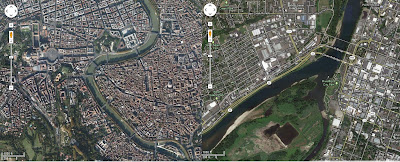Over at No 3rd Bridge, advocates are taking a break while one of them goes to Italy!
The new Pope Emeritus has been in the news of course, and the Vatican looks to be in the news for a while now.
So let's look at Rome! Do those Italians have any lessons? Rome's got a river running through it.
 |
| Rome and Salem, separated by rivers, at the same scale (click to enlarge images!) |
It's astonishing to think how much more dense is Rome and how the patterns of foot traffic in antiquity called for a very different approach to mobility across the river. It's also interesting how much of the riverfront we have not developed, reserving it for park land and industry and private residence.
 |
| Historic Bridges on Nolli's 1748 map of Rome |
You could get lost in it for hours!
Almost always one of the difficulties in thinking about the urban environment in Salem is a certain perspective that takes existing conditions in Salem as permanent and universal - or at least takes them as more enduring and somehow more natural than they really are. It should be obvious that conditions in Salem are transient and particular, the product of a very specific time and place!
 |
| Ruins of Pons Aemilius, Nolli 1748; highlighted in blue and linked to modern photos, other engravings, and the map! Originally constructed in 179 BCE, it's the oldest Roman stone bridge |
I don't know about you, but Tabitha Brown seems impossibly remote to me, but Origen and Augustine practically occupy the same slice of antiquity. They were neighbors! Time's goofy that way.
And while Salem's historic center was developed in the horse-and-buggy and then streetcar era, in 1930 Salem's population was still only 26,266. Today it's over 150,000. As we know it, Salem is a largely product of autoism and the automobile era.
(By comparison, during the empire Rome had a million or more residents. It depopulated dramatically during the middle ages, and wasn't much larger if at all than Salem in 1930 for centuries before the high Renaissance. Around the time of Michelangelo it started growing again, and now it has almost 3 million residents.)
Rome probably doesn't offer much direct lesson for Salem. Private cars are restricted from the central city during much of the week, and violators will be towed or fined. (Imagine that!) Its classical ruins and development in the early modern period proceeded on a very different scale than development in the auto era.
So here's a more interesting question, perhaps: What European cities are about the same size as Salem, either in surface area or in population, and are bisected by a large river? What are their transportation systems like? Instead of the form of the roadway, what about the form of the city? How have they managed hills and rivers?
Are there any interesting comparisons at the level and structure of entire cities? What have you seen in your travels and your reading? (That's your armchair comparative urbanism for a weekend!)


1 comment:
Pittsburgh hit the radar recently. On game days, the Roberto Clemente Bridge is closed to auto traffic. That's another city. much larger of course, more like Portland than Salem, with rivers that's interesting to think about.
Post a Comment